Japanese dog breeds

Japanese dog breeds belong to the smallest group. These pets are mostly smart, quick-witted and friendly. All representatives of Japanese breeds have certain similarities and common features. If you look at them a little more closely, you will notice a large number of differences. This applies not only to the nature of animals, but also to the characteristics of their maintenance.
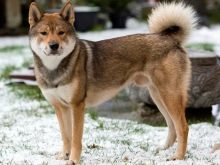
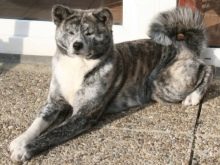
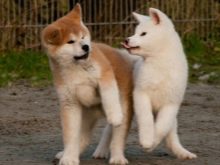
Common features
All four-legged "Japanese" have many similarities that unite them. Let's get acquainted with their list.
- Most of the existing Japanese breeds have soft, triangular ears.
- These dogs most often have smart eyes that are close to each other.
- Purebred "Japanese" have a clean and beautiful coat.
- Most pedigree pets have a charming muzzle with a wedge-shaped structure.
- Japanese breeds have fluffy tails wrapped in rings (directed towards the back of the animal).
- The lion's share of purebred "Japanese" have a very nice and attractive appearance. They do not look aggressively and viciously, which attracts enthusiastic glances from many people.
- All Japanese dogs are characterized by incredible loyalty and loyalty to their owners. That is why the inhabitants of the Land of the Rising Sun call their favorites samurai dogs.
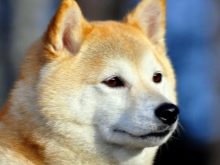
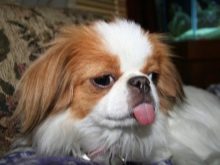

Varieties
The number of dogs of Japanese breeds includes pets that differ in character, and in external characteristics, and in size. The coat color of different pets may also vary. Let's take a closer look at some of the most popular and well-known Japanese breeds.
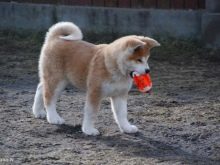

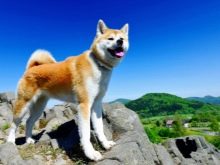
Large
The most famous large Japanese dog is the beauty Akita Inu. This breed was developed over 2000 years ago. Its representatives in weight can reach 45 kg, and height at the withers - 71 cm. From the very beginning, Akita was a very good guard of the imperial family and the Japanese nobility in general. These dogs are insanely devoted to their families.
The appearance of the Akita, like most other Japanese breeds, is peculiar. It is characterized by a large head, triangular eyes (they are very small). The body of a purebred Akita is always strong and dense. These animals are distinguished by sufficient strength and power, which turns out to be the main argument in their conflicts with other animals.

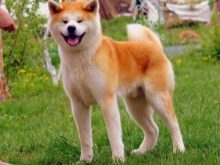

Akita Inu is a wonderful four-legged friend for humans. She will be faithful to her master throughout her life.
For a long time, the Akita Inu simply cannot bark, but it is capable of making unusual snorting or grunting sounds. At times it seems to people that thoroughbred Japanese pets at these moments mutter something under their breath, as if they are talking to themselves. This is one of the interesting features of these animals.
Akita Inu loves to lick his own body. In this business, dogs very similar to representatives of the feline family. In the hunt, the Akita is used to acting like a tiger. She very quietly, without unnecessary sounds, like a cat, tracks down and pursues the victim, and then at the right moment rushes at her.

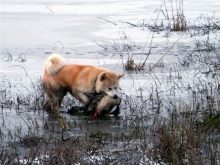
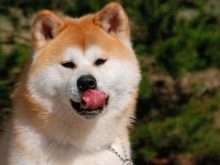
Let's take a look at the main characteristics of these adorable and loyal animals.
- Akita Inu reacts very badly to an angry and aggressive attitude towards himself. It is necessary to bring up such a pet patiently and calmly, without resorting to physical punishment and screaming.
- The understanding with the owner must be complete.
- Akita will always stand up for his beloved master and family members. This is a great defender you can rely on.
- In general, Akita Inu is unpretentious in care. You don't have to spend huge sums on this.
- Like most representatives of other breeds, this dog needs to be socialized as early as possible.
- This pet requires exceptionally correct and balanced nutrition.
- Akita Inu needs impressive daily physical activity.
This breed needs a lot of attention. Without special care, such a pet can cause a lot of problems. Akita Inu must live under the same roof with the owner. This dog usually treats other animals calmly and adequately.
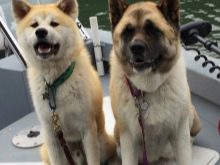
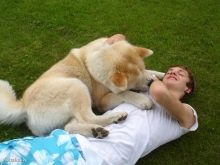
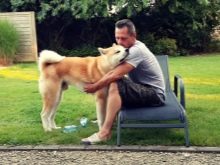
Another large view - american akita... These are large animals with a strong and strong body. Their character is just as serious and strong. They are incredibly loyal to their master. In order for such a dog to treat a person with respect, it must be properly and timely educated. The person himself must also monitor his behavior and treat the animal appropriately. The use of force in training and education is unacceptable here.
Pets of this breed should be educated and trained from an early age... Otherwise, such an Akita will grow up uncontrollable and completely naughty, and after all, no one wants to deal with an uncontrolled 50-kilogram big man. It is advisable to discard boring and monotonous workouts right away. Often, the owners of these pets turn to professional trainers.
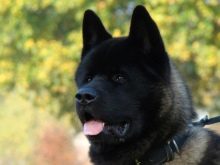

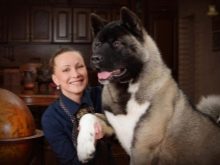
The American Akita gets along well with younger family members. True, too noisy children are often misunderstood by such a dog. In such a situation, the animal may try to put things in order. Leaving Akita alone with children is not recommended - parents should always keep the situation under control.
The American Akita has a very heavy skeleton. For this reason, it is not recommended to expose small puppies to too much physical activity. Before starting to work with the dog, you need to wait until its joints, ligaments and muscles are strong.
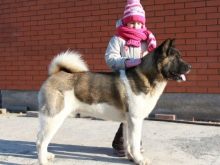
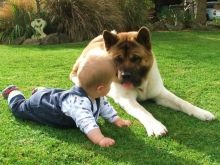

Let's consider the main features of the representatives of this breed.
- Although the coat of these dogs is solid and thick, they do not need frequent brushing.
- During periods of molting, you will have to resort to regular grooming.
- The American Akita should be taken out for walks more often, because within four walls it will be very bored and dreary.
- Such an Akita rarely gets along with other relatives. If she finds herself in the same company with others like herself, she will behave like a leader.
- Representatives of this breed need competent socialization from puppyhood.

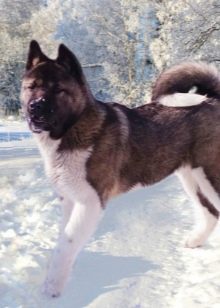
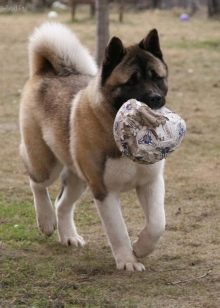
The Tosa Inu or Japanese Mastiff is another large Japanese dog. Initially, this breed was bred to participate in battles. Japanese mastiffs are exceptionally resilient, strong and can rush to the attack at the right moment. These dogs make wonderful watchmen. Tosa Inu are aggressive in nature, so their upbringing requires a lot of attention.
This breed is small in number. Not everyone agrees to get a Japanese mastiff, because this is not a mini-format pocket dog. An adult can weigh up to 70 kg. There are also larger, powerful animals that weigh 100 kg or more.


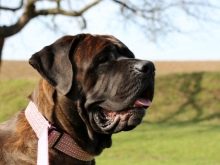
Tosa Inu can demonstrate their fighting qualities against strangers. To avoid such consequences, the pet needs to be properly educated and trained in all the necessary commands. If you do everything correctly, a thoroughbred puppy will make a wonderful companion and loyal companion.
The Japanese Mastiff is not the best option for people who have never encountered fighting breeds. Such a pet is not suitable for a family with children.
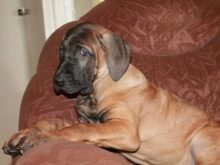
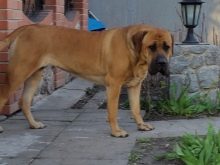
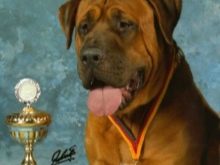
Consider the main features of these animals:
- they are characterized by a large, strong and massive head and the same muzzle;
- the ears of dogs are pendulous, large and fall on the cheekbones;
- the look of the Japanese mastiff is serious and very intelligent;
- the physique is strong, powerful, proportional, the muscles are well developed and clearly visible;
- the skeleton is strong and large, characterized by a wide loin and chest;
- the back is straight and taut;
- legs are straight;
- the coat is short and dense.
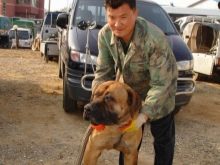
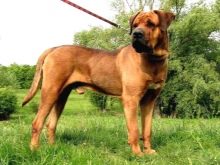

Average
In the list of Japanese dog breeds, there are not only large and massive, but also medium-sized individuals. Many of them can be kept in the conditions of an ordinary city apartment.
So, the middle class includes charming kai-ken. Males of this breed weigh up to 21 kg, and females - up to 18 kg. The growth of the first is 46-59 cm, the second is 46-55 cm.
These pets are distinguished by a very balanced, calm and friendly character. On average, representatives of this Japanese breed live 12-15 years.
Kai are active and energetic dogs. They do not show unnecessary aggression, but they need attention from a person. These animals suffer if they do not spend the accumulated energy. As a result, this translates into bad behavior of pets.
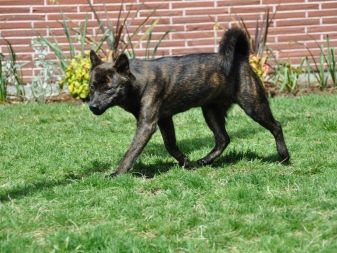

The color of the kai-ken is not simple yellow or red. Representatives of this breed have a spotted coat (tiger tricolor with red, brown or black stripes).
The roots of the Kai are hunting, but in modern representatives of the breed, even slight aggression in behavior is not traced. Such pets will need minimal care, since they have a thick, but very short coat. For a long time, kai do not lose their visual appeal and look neat.
Dogs are also medium in size. hokkaido breeds. Initially, they were taken out for hunting. The second name for pets is Ainu. For a long time, these dogs have been raised to be strong, resilient, courageous, empathetic and ferocious. For their family, the Ainu is a good protector and bodyguard, affectionate, playful and outgoing. This dog will treat strangers with great alertness or aggression.
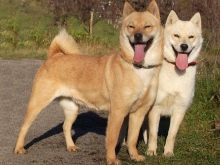


Hokkaido's appearance is very attractive and original. They easily adapt to life even in mountainous areas.It was in such conditions that their main characteristic qualities were developed.
Hokkaido is a primitive breed... Its primitiveness lies in the fact that the formation of the species was carried out under the conditions of natural selection. Consider the main features of the representatives of this interesting breed:
- Hokkaido have a large skull of great width, the forehead is flattened;
- the structure of the muzzle is wedge-shaped;
- the jaws are very powerful, the bite is scissor;
- the eyes of the representatives of this breed are large, the shade of the iris is often dark brown;
- the neck is strong, strong, with well-developed muscles;
- the Ainu language has characteristic spots;
- the withers are pronounced;
- the belly is tucked up, it never hangs;
- the back is well developed, the posture is always correct;
- Ainu's limbs are powerful, especially the hind ones;
- paw pads and nails are black.

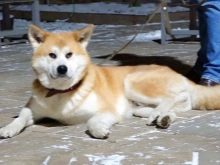

Ainu can be very affectionate and gentle, as well as ferocious. Their main distinguishing feature is dedication and courage. They can easily navigate in any conditions. Ainu are self-confident animals. They act decisively and courageously.
This pet it is recommended to start only strong people, leaders in character. Hokkaido's temper is not the easiest. Most often, these pets are kept in an open-air cage. As needed, they need to be combed using a special brush. Long walks cannot be neglected.

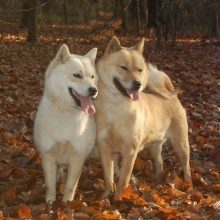
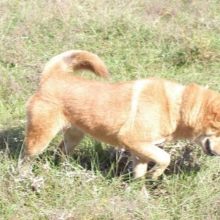
Shikoku are representatives of one of the oldest breeds in Japan. Their homeland is the island of Shikoku. Adult dogs at the withers can reach 52 cm.
The coat of shikoku is short, there is a dense, solid undercoat. Thanks to this feature, this dog does not need frequent and regular brushing. Hair care is simple and inexpensive. These pets have a sickle-shaped tail, as well as a strong body with well-developed muscles.
Shikoku has an active temperament. They are of average size, so they can live in apartment conditions, but they will need to provide constant physical activity. Even if such a pet ends up in a closed environment, he needs to pay a lot of attention.
Every day with such a dog it is necessary to walk alot. From birth, representatives of this Japanese breed have a well-developed hunter instinct. The owner should approach the upbringing and training of such a dog with very great attention and light caution.


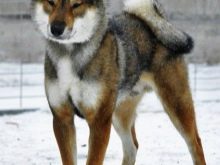
The best place to live for a pure-bred energetic shikoku would be a cozy and spacious house outside the city. Here the dog will be able to play enough, run over. Shikoku are independent in nature. If such animals are brought up according to all the rules, they can easily get along in the same territory with their relatives and other animals.
Dogs of the Japanese breed are classified as service dogs. sanshu. They also make excellent companions and even guards. The color of their coat can be pure white, fawn, red, gray or piebald. The growth of males at the withers reaches only 46 cm, and females - 40 cm.The average life span of these animals is 15-17 years.
Sanshu is very strong and resilient. They are distinguished by their beautiful appearance and kind disposition. These pets can live without problems in a city apartment. They are relatively easy to train and learn, but it is important to keep tact and be patient. The learning process must be consistent and gentle.
Sanshu's wool is thick, so it is allowed to keep such dogs not only in the apartment, but also in the country house. It is required to comb this animal weekly. This procedure is especially important during molting.
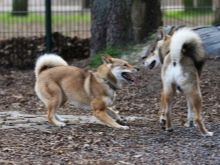
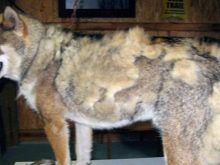
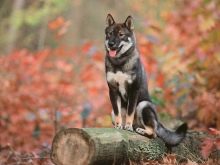
Small
Representatives of small Japanese dog breeds are very popular today. These animals are distinguished by their attractive appearance and compact size, so they are often brought in by people whose living conditions do not allow keeping larger or medium-sized pets.
Four-legged beauties have a special charm hin breed... Their weight rarely exceeds 3.5 kg, and their height is 26 cm. These pets are recognized as the best companions for humans. They differ in that they have a large number of habits inherent in cats.
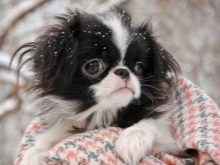
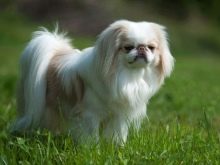
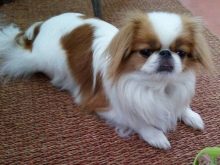
Hin can live seamlessly in almost any room. It may even be a small closet. On the street, representatives of this Japanese breed will not be able to survive, therefore, enclosures for them should not be equipped.
The cute chinas have small ears, a beautiful fluffy tail, and a thick coat. It seems to many people that such a shaggy-headed dog sheds very much, but in fact, if you regularly comb out the chin, there will be no problems with shedding.
Training these little dogs is easy and simple. They fulfill the commands of the hosts with great pleasure. If the training turns out to be too boring and monotonous, the animal may refuse to complete the tasks. We must be prepared for the fact that hin needs a lot of attention from its owners.
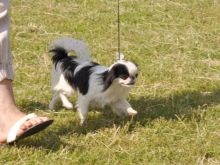
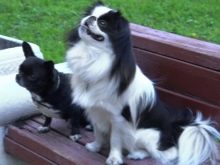
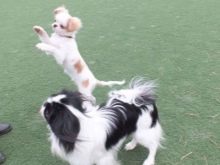
Very popular today cute Japanese Spitz. They are recognized as excellent companions for humans. Sometimes these dogs can be found in circus arenas. They have a characteristic pointed muzzle, like a small fox. The forehead is rounded, and the ears are erect, triangular in shape. These pets differ in a tail with a gorgeous pubescence. He lies on their back. According to the standard, only a snow-white coat is allowed.
The character of these dogs is very cheerful and lively. They bond strongly to their masters and demonstrate lifelong devotion. The purebred Japanese Spitz treats other people with suspicion and caution, often barking. For this reason such pets are allowed to be kept as watchmen.
The Japanese Spitz should be brought up persistently. Note that cowardice is considered a serious flaw. Such pets are immediately excluded from further breeding.

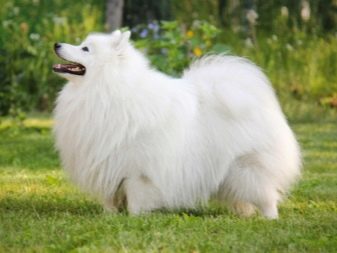
Representatives of the breed also differ in miniature sizes. Shiba Inu (Shiba Inu). Initially, this breed was bred for hunting small forest game. At the withers, their height reaches only 35-43 cm, if it is a male, bitches are even smaller - 33-41 cm.
The muzzles of these plush pets are very cute. From the side it seems that this is a smiling dog. In fact, the Shiba Inu has a fighting character. They are independent, strong animals that need competent education and training. A well-bred and socialized pet will be infinitely loyal to its owner. The trademark of these dwarf dogs is feline cleanliness.
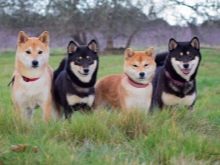

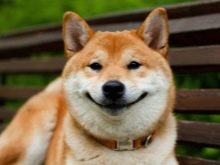
Recognized as an excellent hunter purebred Japanese terrier. This animal can hunt not only on land but also on water. Nowadays, most people keep these pets exclusively as small and productive hunters. This breed is rare as the population is very low. Breeding of Japanese terriers began in the 20s of the last century. Purebred individuals boast an unrivaled keen sense of smell and hearing.
The physique of these dogs is proportional and graceful. They have:
- flat skull and narrow muzzle;
- medium-sized eyes with a dark iris;
- straight back;
- different coat color.
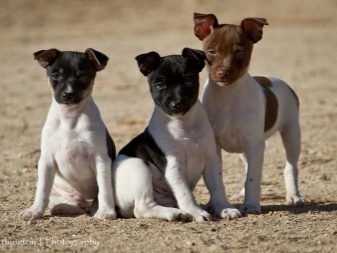

The Japanese Terrier is far from the fluffiest dog. The very structure of her coat is such that she simply will not be able to stay in low temperatures for a long time. Although this is not a bald dog, the compact terrier is suitable exclusively for keeping in a warm city apartment. In such conditions, representatives of this Japanese breed will be excellent companions.
Experts advise walking with such pets. in separate forest park zones. If you went out for a walk with a Japanese terrier in the winter season, then it is advisable to “dress up” it in a comfortable overalls, in which it will not be cold.
Try to protect such a dog from the negative influence of drafts.Otherwise, the terrier runs the risk of becoming seriously ill.
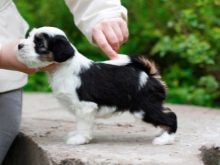
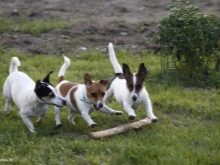

Japanese terriers are incredibly attached to "their person". They are able to quickly detect any changes in the owner's mood. These pets just love it when everyone around them is happy. Terriers always want to be the center of attention in the home. If not played with and left alone at home for long periods of time, these dogs can create a serious mess. Try to give these dogs a lot of attention. Don't make them yearn for you.
Experts say that purebred Japanese terriers in no case should you accustom yourself to the food that a person usually eats. This is especially true for sweet foods in any form. The "Japanese" are developing diabetes rapidly - we must not forget about it.

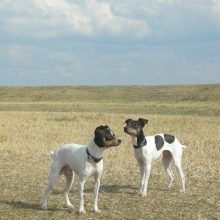
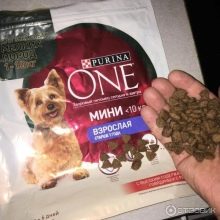
How to choose?
The choice of a puppy belonging to the Japanese breed must be approached with all responsibility. Decide in advance what exactly you want to have a dog and in what conditions you can keep it. If you do not plan to equip a dwelling for a pet in an apartment, then a breed with short hair or a weak undercoat should not be taken. Miniature, dwarf dogs are also extremely rare for keeping outdoors.
Purebred thoroughbred puppies are best purchased in special nurseries with a good reputation. This is due to the fact that most of the Japanese breeds in our country are poorly distributed. Unscrupulous breeders may suggest you a mestizo or just an unclean pet.
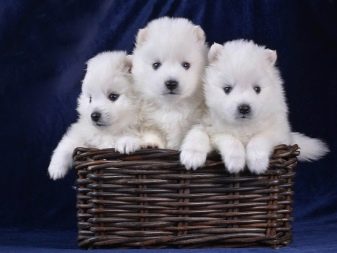
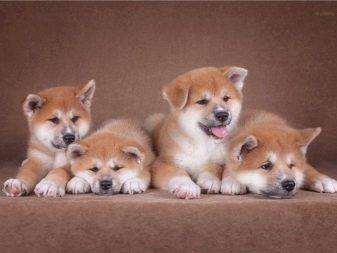
Before buying, you should take a closer look at the puppy. He must be active and healthy. Sluggish movements, painful appearance should push away from the purchase. Take a closer look at the eyes and ears of the animal. They must be absolutely clean, without suppuration and other secretions. It should be under the tail as well.
The puppy must have all the necessary documents. When purchasing a thoroughbred pet in the nursery, you should immediately ask the specialists all your questions. Ask how to feed the dog, how to properly care for it, if you yourself do not know this yet.


Helpful hints and tips
Four-legged representatives of Japanese breeds are insanely popular in our time. They are turned on as wonderful hunters, as watchmen, and as good-natured companions. Having such a loyal and smart friend, it is worth considering a number of tips and tricks from experts.
- If you keep a small chin, you need to make sure that in hot and sunny weather it does not overheat, and does not stay outside for too long under the scorching sun. In such conditions, the pet may begin to suffocate.
- You cannot leave representatives of Japanese breeds without movement. These pets are not lazy and lovers to lie within four walls all day. Be sure to provide the "Japanese" with serious physical activity, walk and play with them.
- Kai are very good hunters, but don't expect aggressive behavior from them. These animals are hardly suitable for the role of watchmen.
- In the upbringing and training of dogs of any Japanese breed, physical punishment or screaming should not be used. It is necessary to educate the "Japanese" carefully, with respect. You need to be patient. If you neglect this recommendation, the pet will not perceive you as his best friend, and there must be a mutual understanding between a person and a dog.
- You should be especially careful when purchasing a purebred Japanese Terrier. Dogs of this breed are not widespread even in their homeland, and it is even more difficult to find them on the territory of Russia. Please contact nurseries only.
- If you decide to get an Akita Inu, you should be prepared for the fact that this animal does not learn so easily. You will have to cope with his temper and character. Experts advise buying puppies of this breed only for very patient people and strong personalities.
- Never feed Japanese dog food from the table.Purebred animals can only eat balanced food without spices, seasonings. Smoked meats, sweets, fried foods and baked goods are prohibited. You can give the "Japanese" ready-made feed, but only premium or super-premium. They are expensive but not harmful to your pet's health.
- If with the upbringing of a thoroughbred "Japanese" you do not succeed in everything, or you are afraid to do it on your own, then it is better to trust the specialists.
Many people trust the education and training of their pets to professionals in order to avoid serious mistakes that can lead to big problems in the future.
For an overview of Japanese dog breeds, see the video below.






































